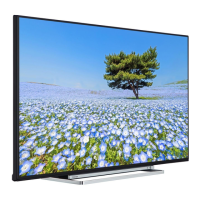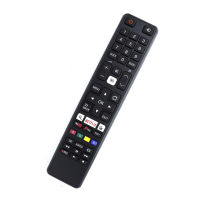Do you have a question about the Toshiba 55U6663DB and is the answer not in the manual?
Crucial safety instructions and precautions for operating the television set.
Details the specific voltage and frequency requirements for the TV's power supply.
Provides explanations for various symbols and markings found on the television product.
Covers risks associated with electrical shock, internal components, and live terminals.
Warns against ingesting batteries and handling them improperly, including chemical burn hazards.
Addresses risks related to TV placement, stability, and potential tipping hazards.
Provides specific warnings and instructions for securely mounting the TV on a wall.
Provides guidance for EU member states on the proper disposal of products and batteries.
Details the TV's compliance with the EU's REACH chemical regulation.
Declares the product's conformity with relevant European Directives and CE marking.
Lists and describes the main functionalities and specifications of the television.
Details the items that come included with the television set.
Explains how to use the TV's physical joystick for various operations like volume and channel changes.
Guides users on how to navigate menus and use functions with the remote control.
Describes the process of switching between different input sources connected to the TV.
Explains how to change channels and adjust the audio volume using the remote.
Step-by-step instructions for correctly inserting batteries into the remote control.
Important information on connecting the TV to a power source after unpacking.
Instructions for connecting the aerial or satellite plug to the TV's input sockets.
Lists and acknowledges trademarks related to HDMI and Dolby Audio technologies.
Details functions of buttons like Standby, Numeric, Quick Menu, Mute, Volume, Menu, and Navigation.
Explains buttons for Netflix, Google Search, YouTube, Favourites, Record, Play, Pause, Stop, Subtitles, and Media Browser.
Describes buttons for Freeview Play, Text (Teletext), Exit, Internet, Info, Programme, EPG, and Source selection.
Provides instructions for turning the TV on, off, and into standby mode.
Steps for initial setup, including language selection and broadcast type configuration.
Guides users on choosing between Digital Aerial, Digital Cable, Satellite, and Analogue broadcasts.
Instructions on configuring the TV's network and internet connection settings.
Explains the need to agree to terms for using Freeview Play services.
Explains the Logical Channel Number (LCN) system for organizing channels.
Instructions for managing satellite data using the SatcoDX feature.
Guides users on how to find and read the electronic manual for TV features.
Details how to access and use Teletext services, including Digital Teletext and BBC Red Button+.
Steps and considerations for connecting the TV to a wired network via Ethernet.
How to configure wired network settings, including Network Type, Speed Test, and Advanced Settings.
Guides users on connecting the TV to a wireless network.
How to configure wireless network settings, including network selection and password entry.
Discusses factors affecting wireless transmission speed and stability.
Instructions for connecting a mobile device to the TV for content sharing using WiFi.
Explains the Wireless Display feature for screen mirroring from mobile devices.
Steps to connect and display content from a mobile device using Wireless Display.
Solutions for problems where the wireless network is not available or not functioning correctly.
Troubleshooting tips for slow network connections and playback disruptions.
Addresses problems with internet connectivity and Audio Video Sharing features.
Instructions on how to install the Nero Media Home program for AV sharing.
How to access and play shared media files using the Media Browser.
Step-by-step guide for downloading, installing, and configuring Nero MediaHome software.
Details the process through the Nero MediaHome installation wizard, including license agreements.
Information on how to connect to and use the Freeview Play platform for catch-up TV.
Steps to choose and launch integrated TV player applications within Freeview Play.
Provides technical details like energy class, screen size, power consumption, and resolution.
Specifies the measurements for VESA hole patterns on the TV for wall mounting.
Details the required screw sizes and threads for VESA wall mount installations.
| Screen shape | Flat |
|---|---|
| Response time | - ms |
| Display diagonal | 55 \ |
| Display brightness | - cd/m² |
| Display technology | LED |
| Display diagonal (metric) | 140 cm |
| Motion interpolation technology | - |
| 3D | No |
| Luminance | 72 % |
| Equalizer bands quantity | 5 |
| Annual energy consumption | 125 kWh |
| Channels quantity (DVB-C) | 800 |
| Channels quantity (DVB-S2) | 10000 |
| Channels quantity (analog signal) | 200 |
| Video apps | Netflix, YouTube |
| Tuner type | Analog & digital |
| Digital signal format system | DVB-C, DVB-S2, DVB-T, DVB-T2 |
| HDMI ports quantity | 4 |
| DVI-D ports quantity | 0 |
| USB 2.0 ports quantity | 2 |
| Ethernet LAN (RJ-45) ports | 1 |
| Sound modes | Flat, Classic, Custom, Movie, Music, Speech |
| Audio system | Stereo sound system |
| Audio decoders | DTS, DTS TruSurround, DTS-HD |
| RMS rated power | 10 W |
| Wi-Fi standards | 802.11a, 802.11b, 802.11g |
| Product color | Black |
| Panel mounting interface | 400 x 200 mm |
| AC input voltage | 220 - 240 V |
| AC input frequency | 50 Hz |
| Power consumption (standby) | 0.5 W |
| Power consumption (typical) | 86 W |
| Package depth | 165 mm |
| Package width | 1369 mm |
| Package height | 874 mm |
| Package weight | 20000 g |
| Depth (with stand) | 290 mm |
|---|---|
| Height (with stand) | 778 mm |
| Depth (without stand) | 93 mm |
| Width (without stand) | 1238 mm |
| Height (without stand) | 724 mm |
| Weight (without stand) | 16000 g |











